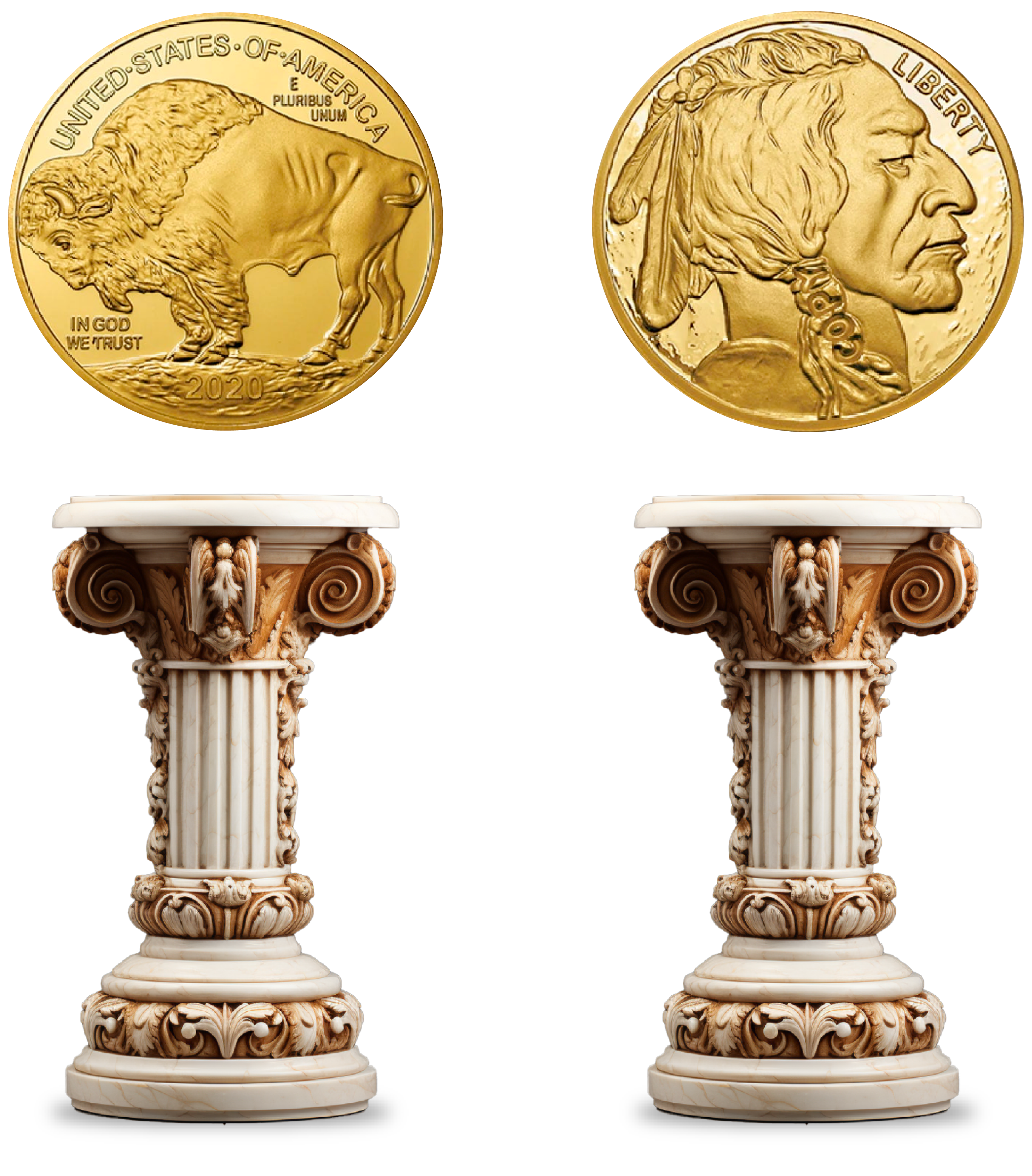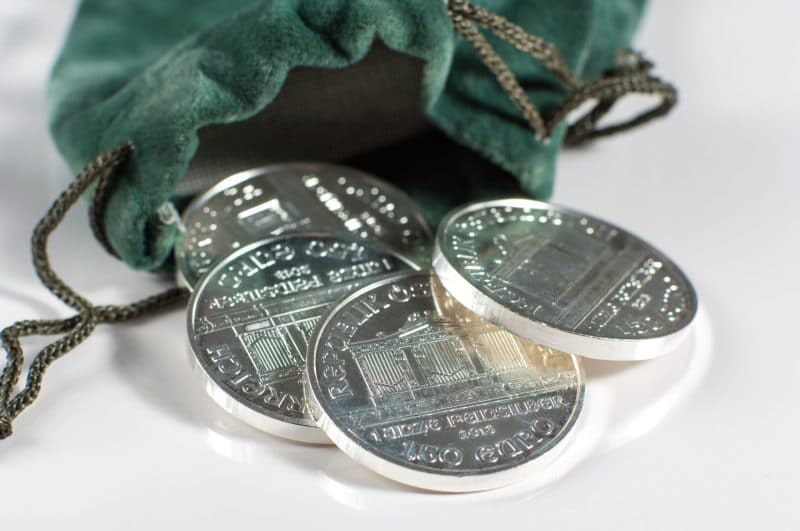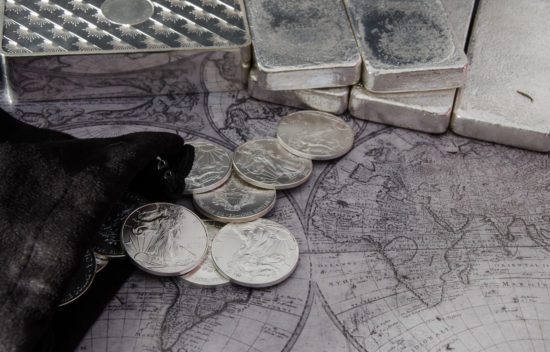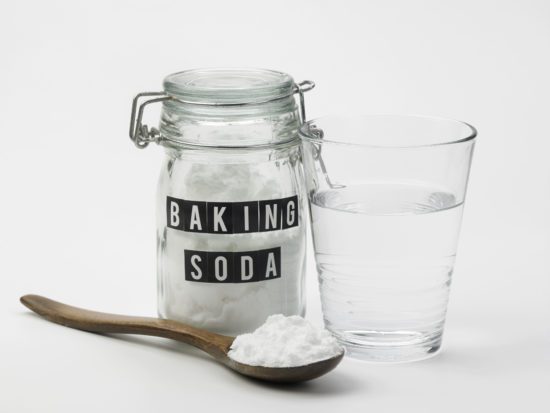
BUFFALO TRIBUTE PROOF COIN
THE HOTTEST COIN ON THE MARKET
How to Clean Silver Coins

Just like gold bars and jewelry made from precious metals, silver coins can tarnish over time. While this process doesn’t affect the quality of silver in the coin, it can impact the resale value for cosmetic reasons. However, you can easily restore the shine and luster of your silver coins using one of many different techniques. In this article, we’ll share all the cleaning methods you can use to make your silver coins shimmer.
From household substances like lemon juice and baking soda, there are plenty of options for your tarnished silver coins. There are lots of reasons to buy silver in 2020, so keep your numismatic collection in pristine condition to get the most from your precious metals investment. Read on to discover why it’s important to keep your coin collection clean, the supplies you’ll need, and how to polish your precious metals to perfection.
There are numerous reasons why gold has the value we assign it. From its various uses in medicine, manufacturing, and even reaching into the cosmetic industry, gold has proven itself to have a vast spectrum of applications. In this article, we’ll break down all the aspects which make gold one of the most coveted substances on earth, and even why it’s more valuable than other precious metals. Read on to discover the different market influences which have an impact on the price of gold. We will also give light to the many uses for gold we benefit from every day.
Why Clean Silver Coins?
As solid silver bars, coins, and rounds age, they tarnish. Dirt and grime can build up, especially on older coins, while oxidation causes changes in color toning. The lifelong investment properties of silver mean you could keep your silver for decades, so you need to know how to keep it in top condition. Clean and shining silver is much more likely to sell when you want to reap your investment, and offers a better price. It’s important to care for your silver investment, which means cleaning coins the right way. This makes them more desirable and preserves luxurious value.
Why Do Silver Coins Tarnish?
Tarnishing is a chemical reaction that can occur when silver metals come into contact with humidity. Chemicals in the air react with the humidity in the silver causing it to lose its luster and shine. A layer of silver oxide is created on the surface of your coin when the metal reacts with oxygen, and like rust, it performs a protective (yet unattractive) barrier around the coin. Don’t worry; this chemical reaction is limited to the outer layer of your coin and can be easily remedied. This process is common with a host of other precious and semi-precious metals, including copper and brass.
Sometimes, this process of oxidation can lead to colorful toning. Some find toning attractive as it can produce rainbow colors on silver coins like the United States Franklin Half-Dollar. It’s up to personal preference, however, most dealers will prefer a whining white metal coin. Most toning and tarnishing can be removed with one of several simple processes, but there are cases where the reaction has gone too far. Very old coins can sometimes feature deep, black oxidation, and even pitting on the metal’s surface. This is a sign that the tarnishing process has gone too far, but the silver still has value.
Most coin collectors will recommend never using harsh chemicals to clean rare and valuable coins. This is especially the case for coins with historical value, as you risk removing the natural surface shading on the coin, and making microscopic abrasions on its surface. Whether you keep silver coins as a keepsake, a collector’s item, or a silver bullion investment; clean and tarnish-free coins are always the preferred choice.

The First Step To Clean Silver Coins
Before you start using chemical reactions, cleaning solutions, and far-fetched methods to clean your silver coins, it’s best to start with simple soap and water. This can help remove that first layer of dirt and grime that can build up on a coin over the years. Once this is clear, you can better assess the coin’s condition, and you don’t have to worry about damage with this gentle cleaning technique. You’ll need water, mild dish soap, and a plastic container. We recommend using distilled water for this process as chlorinated tap water can cause discoloration in the coins. If you have any 925 Sterling Silver jewelry, you can clean that using this method too.
1. Fill a large plastic container with hot water and a few drops of mild dish soap. Submerge your coins in the soapy water and soak them for as long as they need, flipping them over every couple of hours.
2. If your coins are especially dirty, you may need to soak them for several days, replacing the soap and water with a clean mixture daily.
3. For stubborn dirt, you may need to gently scrub your coins with a soft-bristled toothbrush. Be careful not to rub too hard so as to avoid damaging your coin.
4. Once your coins are clean, rinse them under cold water and leave them to dry.
This gentle cleaning process using mild soap and hot water is a great place to start when cleaning silver coins. Don’t worry if your coins don’t look perfect yet, there are many more methods for removing leftover dirt and returning luster and shine. If your coins are still dirty after this first technique, check out our next set of instructions using the freezing and cleaning method.
How to Clean Silver Coins With Toothpaste
Coins muddied with dirt and grime over time can be cleaned by either freezing the dirt off or using a simple solution of soap and water. Both of these methods can be used to remove physical dirt from the surface of silver coins. However, this process can render coins dull and lifeless. If you want to return the shine to your silver coins, you can try this method using toothpaste. Cleaning coins with toothpaste is similar to using silver polish, but the materials are available for much less.
All you need is a tube of toothpaste, any variety will work fine. If you can find tartar control toothpaste, this contains the ingredient hydrated silica, which is even more effective at cleaning silver. You’ll also need some paper towels for this technique. As well as returning shine to your silver coins, you can also use toothpaste to clean silver jewelry. This method is cheap, easy, and very effective at returning shine and luster to your silver metal.
Here’s how to clean silver coins with toothpaste:
1. Squeeze a small amount of toothpaste onto the surface of your coin, which should already have been cleaned using one of our previously listed techniques.
2. Rub the toothpaste into one side of the coin with your fingertips, trying to get the substance into every crevice and groove.
3. Take a paper towel and use it to buff and polish the toothpaste from the coin. Rub until you cannot remove any more toothpaste, and then rinse the coin with clean water.
4. Set aside the coin to air dry, and repeat the process on the other side if necessary.
This method for cleaning silver coins with toothpaste is a great way to make them look new without needing any special supplies. Using only items found around the home, you can remove dirt and polish up silver coins with these easy techniques. However, while the methods we’ve mentioned so far are very effective at removing dirt and returning shine, they won’t work on tarnished coins. If this chemical process has taken place, you’ll need a more complex cleaning technique to restore your silver coins. Read on to find out how baking soda and tin foil can remove tarnish from your silver coins.
Cleaning Silver Coins With Baking Soda
One of the most popular methods for cleaning silver coins uses a range of everyday household items. This technique is highly effective at removing tarnish, without needing any special cleaning products. You’ll need a cooking pan or plastic container to clean the coins inside, as well as hot and cold water. Aluminum foil is needed along with a new container of baking soda to create the chemical reaction which removes the tarnish. It’s a good idea to have some paper towels around to dry up any spillage, as well as some latex gloves to protect your hands without abrading the silver.
How to Clean Silver Coins with Baking Soda:
1. Line your entire container with aluminum foil, with as few gaps as possible. You can use multiple layers if necessary, just make sure every area is covered.
2. Open a new pack of baking soda and pour a layer over the bottom of your container. You shouldn’t be able to see any foil in the base of the tub, so be liberal with the baking soda.
3. Take your tarnished silver coins and place them in the container on top of the baking soda. Set them with the most tarnished side facing up, then add more baking soda to cover up the coins completely.
4. You’ll need approximately 2 cups of warm, but not boiling water. Pour the warm water into the container; you may need to add more until the coins are fully submerged. After filling with warm water, sprinkle in additional baking soda where the silver coins are.
5. Allow the mixture to soak for at least 5 minutes.
6. Wearing the latex gloves, reach into the container, and gently rub the silver coins. By scrubbing them in the water and baking soda mixture, you’ll help to remove as much tarnish as possible. Just take care to be very light-handed- too rough and you can scratch your silver coins. Make sure you rub the tarnishing from both sides and the edges. You can rinse and reapply baking soda to stubborn areas of tarnish.
7. After you’ve finished cleaning the silver coins, rinse thoroughly in cold water. If you skip this step, any remaining baking soda could dry and form white spots on the surface of the coin.
8. Dry the silver coins with paper towels and inspect them. If your coin was heavily tarnished on both sides, you may need to repeat the process again with the coin flipped the other way up. Otherwise, your silver coin should now be clean and shining like new!
This is an easy method you can use to transform old tarnished silver coins into shining specimens, using only items you can find around your home. The simple chemical reaction using aluminum foil and baking soda is highly effective at removing tarnish from silver coins, returning them to their former glory.

Cleaning Silver Coins with an Acid Bath
If you have particularly dirty silver coins, perhaps that feature dark tarnishing in some spots, you might want to consider a more heavy-duty coin cleaning technique. An acid bath can be highly effective in loosening very hard-packed dirt and shifting some of the darkest tarnish. You can use any acidic liquid for this process, household items that work well include lemon juice and white vinegar. To clean your silver coins with an acid bath, follow these steps:
1. Pour lemon juice, white vinegar, or any acidic liquid into a plastic container.
2. Place your silver coins that need cleaning into the liquid, ensuring they are fully submerged. Your coins should not overlap or touch each other.
3. Allow the coins to soak in the acidic solution for a whole 24 hours. If you want to speed up the reaction, add a few small iron nails to the container. These will accelerate the process to only half an hour.
You can use this simple acid bath to clean all sorts of stains off silver coins, and it works for other precious metals too. Even stainless steel can shine again using this method, so don’t hold back when cleaning your silver coins.
Cleaning Silver Coins with Electrolysis
If you’re serious about cleaning your silver coins, you might be okay with a higher level of commitment than these cleaning methods. One incredibly effective way to clean silver coins is through the process of electrolysis. You may remember learning about this process in school, where an electric current is used to drive a chemical reaction. Using science to clean up your silver investment is a lot of fun, and easier than you may think. This method is similar to cleaning silver coins with baking soda, except by adding in an electrical current the cleaning is much more effective.
No matter how heavily tarnished or filthy your silver coin is, electrolysis will have it shining in seconds. Using this method means you don’t have to polish or scrub your coins, meaning you don’t risk scratching and damage. Rather than removing tarnish, this wonderous process actually reverts the chemical reaction; turning tarnish (silver sulfide) back into shining silver metal. Using electrolysis to clean your silver metals requires a few more supplies than other methods, however, the incredibly fast results are worth the effort.
To clean your silver coins with electrolysis, you’ll need aluminum foil, distilled clean water, a glass broiling pan, table salt, and baking soda. You will also require four AA batteries and a pair of alligator clips to create the electric current, as well as some electrical tape. The final item you’ll need to clean coins with electrolysis is a piece of copper such as scrap metal, or a penny, which reacts in the process to clean your coins. This will be damaged in the process so don’t use anything important. When you’ve gathered all the supplies, follow our instructions to clean your silver coins using electrolysis:
1. Start by adding a few tablespoons each of salt and baking soda to a pitcher of warm distilled water. Stir the mixture to ensure it’s fully dissolved; this makes the water more conductive to electricity.
2. Line your glass dish with a large piece of aluminum foil, and be careful there are no gaps or holes.
3. Now you need to create a power supply to fuel your reaction. Connect the four AA batteries in series to form a 6V power source. If you don’t know what this means; line up the batteries positive to negative, and secure them together with electrical tape.
4. Ensure the metal connections are in contact, and tape one alligator clip to the positive end of your joined batteries. Tape the other to the negative end.
5. Take the positive alligator clip and attach it to your piece of copper, for example, a penny. Then, place the copper in the bottom of your foil-lined dish. Try to make the clip lie flat at the bottom.
6. Pour the baking soda and saltwater solution into the glass dish, making sure enough liquid is in the container to fully submerge the copper piece as well as the coin you’ll add next.
7. Attach the alligator clip from the negative terminal of your battery pack to the silver coin you’d like to clean.
8. When the connection is secure, it’s time to place your coin in the water for electrolysis. Submerge the coin fully but be very careful it doesn’t touch the copper piece connected to the other end of your battery.
9. Now, watch as in seconds all of the tarnish and dirt is removed from your coin. You will see bubbles of hydrogen in the water, which will get dirtier as your coin gets cleaner. It only takes a couple of minutes for the process to be complete, after which you can remove your coin from the solution.
10. Disconnect your silver coin from the negative alligator clip, and rinse it under lean water. If you aren’t satisfied with the cleanliness of your silver coin, you can reconnect and resubmerge, repeating the process until your silver shines!
Using this scientific process to clean your coins is very effective, especially if you have a number that need attention. The setup might seem like a lot of work if you only have one coin to clean, but a whole collection can be made to sparkle in just a few hours with this method. When you’ve finished, a quick buff with a jewelers cloth will have your silver coins shining as if they were only just minted.
Make Your Silver Coins Shine
Many people around the world own silver coins for different reasons. Some people value the collectible aspect of ancient and rare coins, whereas others see silver as a smart new investment. No matter the reason, every coin needs care and attention to remain in the best possible mintage. You can use any of our methods to remove dirt and tarnish from your silver coins and help them to shine once more. From common silver dollars to Silver Eagles from the US Mint, coin dealers all over will be pleased with clean metal. Keep your silver coins in top condition for the best return on investments, and the most pride in your collection.

